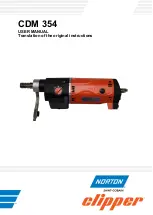
12
Parts & Service: 020 8988 7400 / E-mail: [email protected] or [email protected]
DRILLING TIPS
• Always use sharp, good quality drill bits. The performance of your drill is
dependant on the quality of the bits used.
• After drilling material to the full depth, do not simply pull out the drill but
maintain chuck rotation to ease withdrawal.
• Reduce the pressure on the drill bit when it is about to break through. This
will prevent the drill from jamming.
• If drilling a large hole, first drill a pilot hole using a smaller drill bit.
• Always apply pressure to your drill bit in a straight line and, where
possible, at right angles to the workpiece.
• When drilling in metal, the materials being drilled can become hot. To
reduce overheating use a suitable cooling lubricant. No cooling
lubricant is necessary when drilling cast iron or brass as they should be
drilled dry.
• When drilling metal, the harder the metal the slower the drill speed.
Similarly, the bigger the drill bit the slower the speed.
• To prevent the drill bit from slipping when starting to drill a hole in metal,
use a centre punch to make an indentation at the start point.
• Always start drilling at a slow speed to prevent the drill from slipping out
of the pop mark or indent, gradually increasing speed until the optimum
cutting speed is achieved whilst maintaining a MODERATE pressure
ONLY. NEVER force the drill bit into the work. This will overheat the tip and
cause it to dull very quickly.
• When drilling in wood, clamp a piece of scrap wood to the underside of
the material to avoid splintering.
• Large holes should be drilled with wood augers, flat wood bits or hole
saws.
Содержание 6480215
Страница 16: ......


































